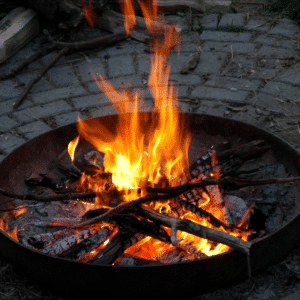Why You Should Not Remove 3rd Degree Creosote From Tile Liners
In tile-lined chimneys, it’s the exceptional chimney that has good mortar joints. In fact, if I were to blindly bet ten people $10 that their chimneys have poorly sealed mortar joints and then we investigated with a closed circuit chimney inspection camera, I stand a good chance of making $100. I might lose one or two $10 bets, but that’s about all.
The problem with having openings in the system is that liquid creosote can and does go through the joints and/or cracks and accumulates outside of the flue tile. This is a very serious problem because in a chimney fire this creosote ignites as well and becomes a slow-burning creosote fire not contained inside of a liner. A house fire becomes a much greater possibility.
It is probably best to consider unsafe any chimney that has had 3rd degree creosote in it, especially if there has been a chimney fire. Frankly, even if servicemen remove as much creosote as possible, the cleaning does not yield as much safety you’d hope for.
In short, it’s probably best to remove the old tiles completely (getting rid of creosote on the outside of the tiles as well) and replace the liner with a new insulated stainless steel liner. Here’s why.
The reasons there are bad mortar joints or cracks in chimneys are numerous, including:
- Some masons “work too fast” and don’t think it’s actually important to seal the joints.
- The wrong mortar is very often used, or dries too quickly and falls out after construction.
- The earth is always shifting and the stack of tiles moves over time. This can open mortar joints and sometimes even crack the tiles. No matter how good the original job may have been, no one can protect against this.
- Flue tiles that have contained a chimney fire almost always crack. They protect the home from fire, but the tiles themselves usually break and mortar is demolished. This is actually to be expected; it’s the exception if it doesn’t happen.
Before the 1970’s wood heating appliances had lower heating efficiencies. This was partly because the wood was not as fully consumed, but also because a lot more heat went up the chimney. This combination usually produced 2nd degree creosote, which is manageable. Today’s wood burning stoves are very well engineered to get more heat from less wood, and houses are tighter than ever. Chimneys routinely create 3rd degree creosote (because of the lack of combustion air and the low flue gas temperatures.)
This is why you see so much stainless steel chimney lining done these days. The chimneys of America are undergoing change as they are being properly sized to their appliances, either by upgrade or by repair.
The stainless steel liners are:
- The right size for whatever appliance they serve.
- Flexible enough to shift with the earth.
- Able to withstand chimney fires without breaking.
The reluctance to reline chimneys can indeed be attributed to several factors, including cost considerations and a lack of understanding of the necessity. However, there are potential solutions and initiatives that could accelerate the adoption of stainless steel liners for improved chimney safety and efficiency:
-
Cost Concerns: Chimney relining can be a significant investment, and many homeowners may not have budgeted for it. To address this issue, some solutions include:
- Government Incentives: Governments at various levels can provide financial incentives, tax credits, or rebates to encourage homeowners to invest in chimney relining for safety and environmental reasons.
- Insurance Discounts: Insurance companies could offer discounts or reduced premiums to homeowners who have their chimneys relined with stainless steel liners. This would incentivize safer heating practices.
-
Lack of Understanding: Education and awareness campaigns can help homeowners better understand the need for chimney relining:
- Public Awareness Programs: Organizations and government agencies can run public awareness campaigns to inform homeowners about the dangers of outdated chimney systems and the benefits of stainless steel liners.
- Home Inspections: As part of standard home inspections, inspectors can inform prospective buyers and current homeowners about the condition of their chimney and the potential need for relining.
-
Regulations and Building Codes: As you mentioned, building codes and regulations play a significant role in driving change. Authorities responsible for building codes and safety standards can consider implementing or updating regulations related to chimney liners. This might include requirements for stainless steel liners in certain situations or phases of construction.
-
Insurance Requirements: Insurance companies have the power to influence homeowners’ decisions. They can mandate that policyholders comply with specific safety requirements, including chimney relining with stainless steel liners, as a condition for coverage.
-
Environmental Awareness: Promoting the environmental benefits of using stainless steel liners can also be persuasive. Relined chimneys are more efficient, reducing the amount of wood needed for heating and decreasing air pollution.
-
Professional Guidance: Homeowners often rely on the advice of chimney professionals. Encouraging these professionals to recommend stainless steel liners as a best practice for chimney safety can drive change.
-
Industry Collaboration: Chimney professionals, manufacturers, and regulators can collaborate to develop industry standards and guidelines for chimney relining. This can ensure that relining is done correctly and safely.
Conclusion
In conclusion, addressing the challenges of chimney relining adoption will require a multi-pronged approach involving government incentives, insurance incentives, public awareness campaigns, updated regulations, and collaboration within the industry. With these efforts, it’s possible to accelerate the transition to safer and more efficient chimney systems for homeowners across the country.

